Ten things to know about USDOT’s new proposal for measuring traffic congestion
For the first time, USDOT has released new requirements for how states and metro areas will have to measure traffic congestion. While the new rule marks a continued, necessary shift to assessing what our federal transportation dollars actually accomplish, this proposal as introduced doubles down on outdated measures of congestion that will push local communities to spend billions of dollars in vain attempts to build their way out of it.
UPDATE: The comment period is open. Click here to sign and send a letter that we (along with Smart Growth America) will deliver in person to USDOT before the comment period closes.
Curious to learn more about this rule? Join us for an online discussion next Wednesday, April 27th from 1-2 p.m. EST.
For two years, USDOT has been working to establish a new system of performance measures to help govern how federal dollars are spent and hold states and metro areas accountable for making progress on important goals. This proposal for congestion (and several other measures focused on “system performance”) is the last of three sets of new Federal Highway Administration (FHWA) rules that will be finalized in early 2017.
Though this represents an incredibly important and necessary shift toward measuring what our transportation spending actually accomplishes, using the wrong measure for congestion will help advance projects that divide communities, cut people off from opportunity, and cost billions of dollars (we don’t have) in the name of solving “congestion” by trying in vain to keep traffic moving.
As we laid out in our post on congestion last week, how we measure congestion matters.
There’s a direct connection between how we decide to measure it and how we choose to address it. If we focus, as this rule does, on keeping traffic moving at a high rate of speed at all times of day on all types of roads and streets, then the result is easy to predict: our solutions will prioritize the investments that make that possible, regardless of cost vs. benefits or the potential impacts on the communities those roads pass through.
Here are ten things you need to know about this new rule from USDOT and what you can do about it
#1 The rule undermines Secretary Foxx’s unprecedented effort to connect communities and use transportation to give people greater opportunities
Transportation Secretary Anthony Foxx recently launched a campaign based on the stunning admission that federal policy had long incentivized poorly designed highways that isolated communities and cut people off from jobs and opportunities.
Springing out of powerful personal examples he saw firsthand growing up in Charlotte when new freeways were built “to carry people through my neighborhood, but never to my neighborhood,” he expressed his firm commitment to ensuring that our transportation investments connect more people to opportunity and knit communities together — rather than divide them.
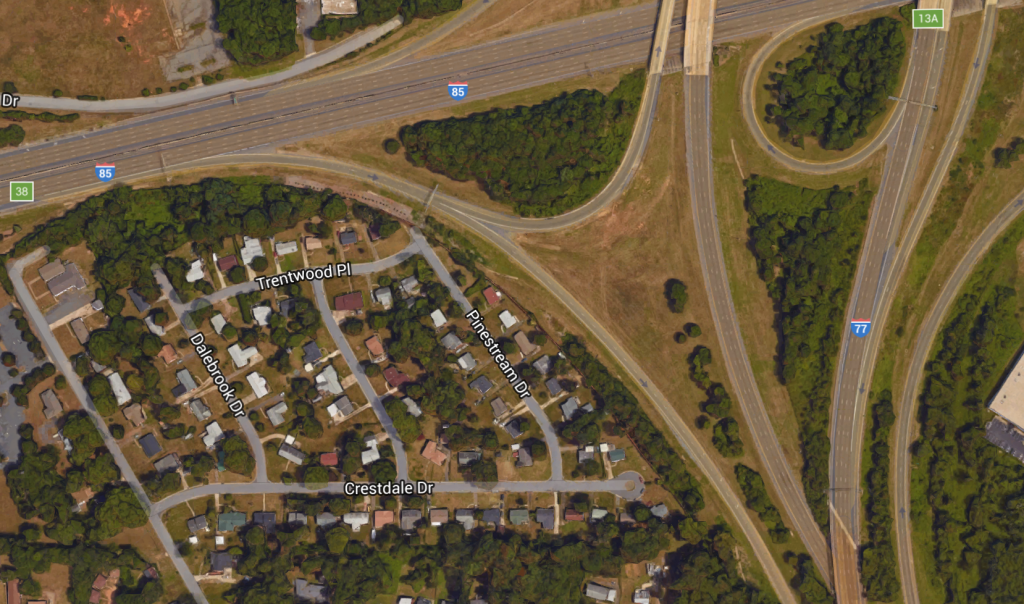
Where the streets around Secretary Foxx’s childhood neighborhood dead-end into Interstates 77 and 85 in Charlotte, NC
It’s an inspiring effort, but as he said, “These principles sound very easy, but they’re really hard and they’re also very necessary if we’re going to make transportation work for everybody.” This rule produced by FHWA illustrates the uphill battle against the institutional inertia for the old way of doing things.
This proposal also undercuts the Secretary’s ongoing Mayors’ Challenge for Safer People and Safer Streets intended to “help communities create safer, better connected bicycling and walking networks,” explicit requirements from Congress to design streets safe for all users, and the nearly 900 communities that have passed complete streets policies to do the same.
“We’re trying to be more attuned, but it’s not a situation where the federal government is solely in control. We can’t tell a state what project to do. They have to make those determinations,” Sec. Foxx noted.
Indeed, states and metro areas will still be making the bulk of the decisions. Yet through this rule and other guidance, USDOT can absolutely usher in a new paradigm by steering states and metro areas to a more holistic approach for measuring traffic congestion that counts all people in a community by counting all modes of transportation. And we will need your help to hold USDOT’s feet to the fire to make this change happen.
#2 Focusing on delay is simply the wrong measure for addressing congestion
USDOT plans to measure vehicle speed and delay seven different ways, while ignoring people carpooling, taking transit, walking & biking or skipping the trip entirely.
A host of people and groups from all across the map, including T4America, have already explained in detail how a singular focus on delay for drivers paints an incredibly one-dimensional picture of congestion. Focusing on average delay by simply measuring the difference between rush hour speeds compared to free-flow 3 a.m. traffic fails to count everyone else commuting by other modes, rewards places with fast travel speeds at the expense of places with shorter commutes and less time spent behind the wheel overall, and completely ignores how many people are actually moving through the corridor.
This measure treats a corridor filled with buses or carpoolers the same as a corridor filled with single-occupancy vehicles. It ignores millions of people who opt out of congestion entirely by taking transit, telecommuting, walking or biking, and even penalizes places where people get to take shorter trips. While USDOT’s proposal to measure delay per capita at least begins to recognize that not everyone in a region is stuck in traffic on the highway, it still fails to measure how many people are moving through a corridor.
Shouldn’t the actual impact on real people be the core principle of anything we measure? Any traffic congestion measure should lead us to solutions that increase access to opportunity for everyone — regardless of how they travel each day.
#3 You can’t manage what you don’t measure
In the pointed words of a USDOT official earlier this week, “you can’t manage what you don’t measure.” The really staggering thing is that FHWA knows they’re missing the boat on measuring other crucial things that paint a more accurate picture of delay. From their own words in the 425-page rule:
As with delay metrics, FHWA acknowledges that travel time indices do not capture system attributes in terms of shorter trips or better access to destinations and mode options, which may occur at the expense of greater delay.
True. So let’s find a better way than focusing narrowly on delay.
#4 USDOT should stick with reliability and dump delay
One of the few positives is that (in one of the measures), USDOT recognizes that predictability is incredibly important. The rule includes a people-centric metric of “reliability” — whether a trip on a corridor takes the same amount of time from one day to the next. While completely eliminating rush hour congestion isn’t either possible or affordable, what many travelers are looking for is the basic assurance that their morning commute will take the same amount of time each day, allowing them to plan their trips with predictability.
But reliability for whom? Unfortunately, this rule only considers the reliability of those traveling by car, and will ignore whether or not your transit trip is hit or miss.
Though one of the other measures is labeled “reliability,” it’s just another measure of delay in sheep’s clothing: It defines “reliability” as trips taking the same amount of time at any time of the day – middle of the night or rush hour — an incredibly unlikely scenario.
#5 When it comes to congestion, this treats highways the same as main streets — and could do real harm to our most economically vibrant places
Take a look at these two sets of streets from Nashville and Charlotte. First: US 41/Clarksville Pike in northern Nashville, and then Broadway in downtown Nashville.
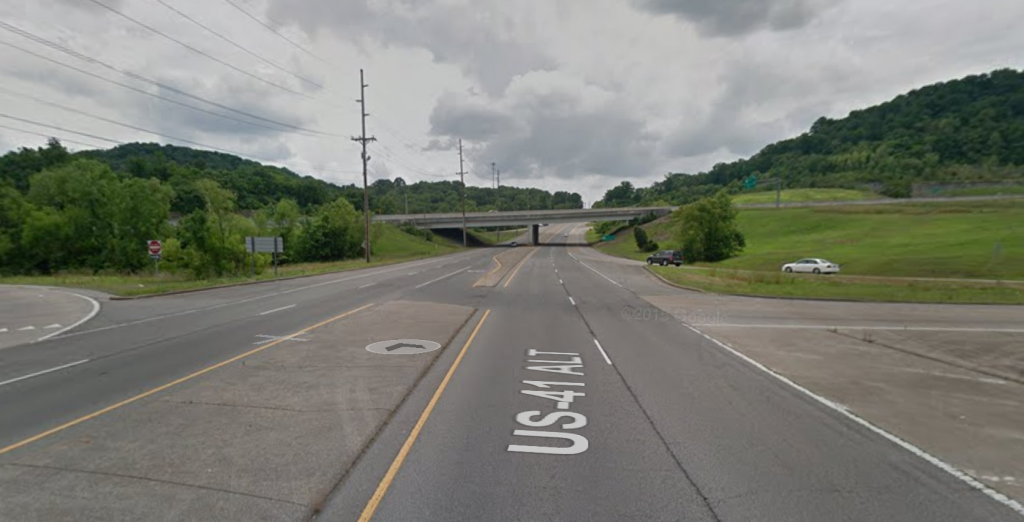
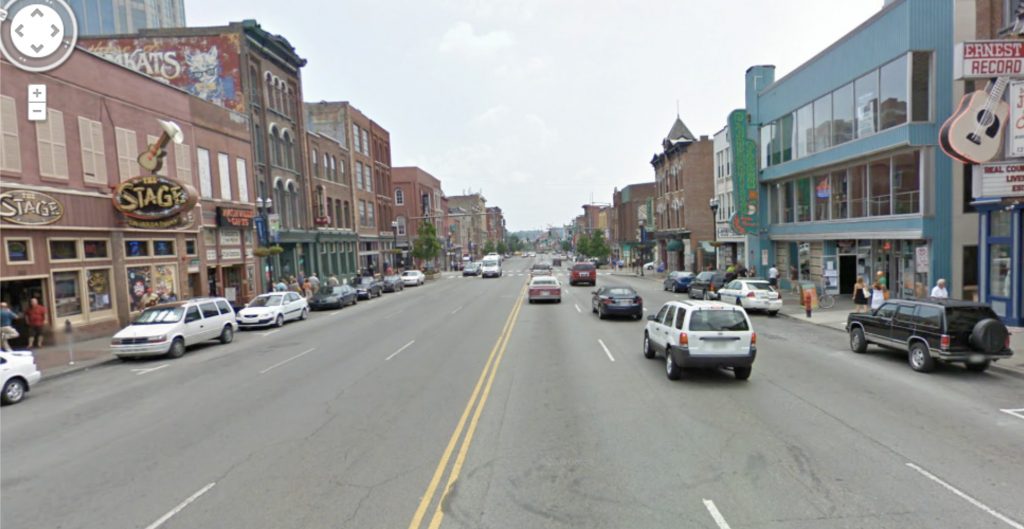
And Brookshire Blvd/NC-16 headed south into Charlotte, and Tryon Street near downtown
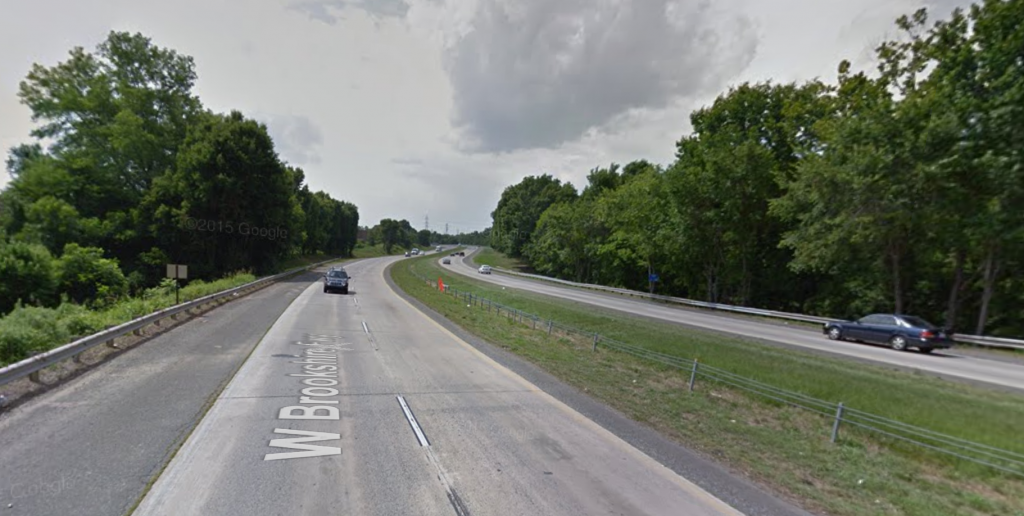
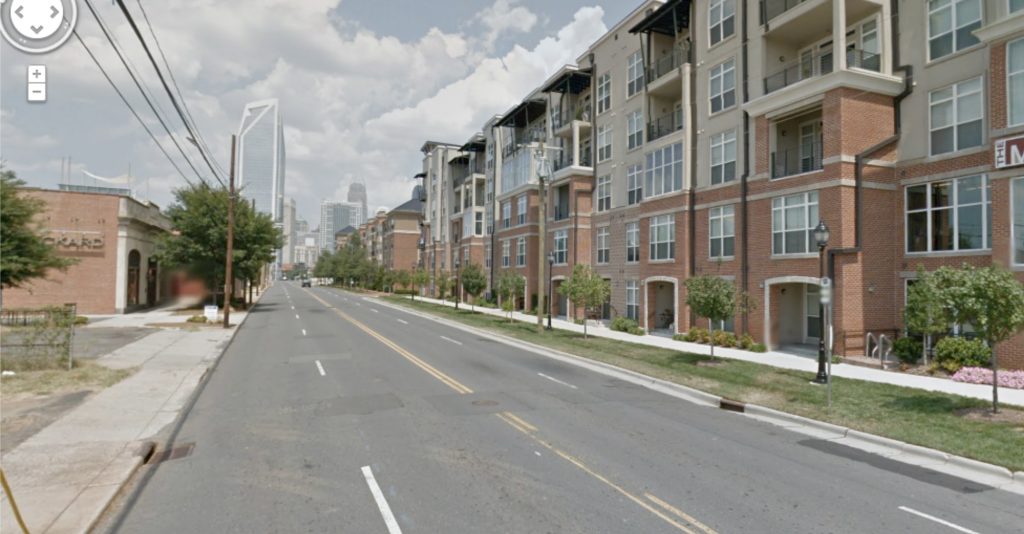
Are the needs of all of these streets the same? Do they all need to accomplish the same thing? Should we expect them to function the same way?
Partially because of a decision made all the way back in 2012 in MAP-21 to expand what’s known as the National Highway System to include nearly every four-lane (or larger) road — regardless of what kind of traffic it carries or where it passes through, this measure proposes to measure congestion roughly the same way on all of them.
Whether in a rural small town or a big city, the needs of our country’s main streets are radically different from the highways and interstates designed to connect disparate places. For a main street to function well, it has to serve everyone who needs to use it.
On a main street, that which looks like “vehicle delay” to a traffic engineer looks like economic activity and success to a local merchant or mayor on a main street.
#6 USDOT ignores the innovative things other states and metro areas are already doing
California has already moved to scrap level of service (LOS) as an evaluation criteria for transportation projects, one that has typically resulted in the same outcomes as this narrow congestion rule. As Angie Schmitt wrote in Streetsblog back in January:
Instead of assessing how a building or road project will affect traffic delay, California will measure how much traffic it generates, period. Car trips, not car delays, will be the thing to avoid. This is likely to have the opposite effect of LOS, leading to more efficient use of land and transportation infrastructure.
At the same time that USDOT is proposing to double down on 1960’s measures for traffic congestion, other metro areas across the country are setting ambitious new goals and accompanying performance measures for improving health, improving access to jobs for more people or expanding transit to connect more people to opportunity.
#7 We can’t wait to develop better measures until we have the “perfect” data
Throughout the rule’s 425 pages, USDOT continues to perpetuate the myth that they lack adequate data to measure other modes of transportation, ignoring sources like (their own!) National Transit Database, the U.S. Census American Community Survey, and cell phone network data among others. USDOT invested millions of taxpayer dollars after the passage of MAP-21 to procure the data necessary to develop these vehicle-only measures. If USDOT is spending our money to collect data then they must find ways to acquire the data needed to better measure the entire system and all of its users.
#8 It puts containers above commuters
By defining congestion on interstates as speeds below 35 mph for commuters but below just 50 mph for freight trucks, this rule strangely prioritizes the needs of freight movement at the expense of people. While the movement of freight is indeed incredibly important, it should be on a level playing field with the people picking up the majority of the tab for the system’s maintenance. (To say nothing of the difficulty of actually implementing different standards for various types of vehicles on the same roadway.)
This rule also sets an impossible standard for freight movement in urban settings. Freight bottlenecks obviously occur far more often in urban areas where demand is far greater. Does anyone think that it’s feasible or affordable to spend enough or build enough capacity so that trucks can travel at 50 mph through the middle of major cities during rush hour?
#9 It undercuts the goal of protecting and enhancing the environment
This rule does include more than just measures for traffic congestion, including a requirement to measure mobile source emissions (i.e. pollution from vehicles). Yet states and metro areas would only have to measure the impact of the few projects funded by the relatively tiny Congestion Mitigation and Air Quality (CMAQ) program, which is akin to not being required to reduce highway deaths on a road because that road was built with highway dollars instead of safety improvement dollars.
Though the rule makes a first-ever move to include language on measuring the contribution of the potential emissions impacts of transportation, it stops far short of actually including any requirements with teeth. As Joe Cortright wrote earlier this week:
Despite some hopes that the White House and environmentalists had prevailed on the USDOT to tackle transportation’s contribution to climate change as part of these performance measures, there’s nothing with any teeth here. Instead—in a 425 page proposed rule—there are just six pages (p. 101-106) addressing greenhouse gas emissions that read like a bad book report and a “dog-ate-my-homework” excuse for doing nothing now. Instead, DOT offers up a broad set of questions asking others for advice on how they might do something, in some future rulemaking, to address climate change.
#10 We still have a chance to improve this rule — but we’ll need your help to do it
The comment period for this rule isn’t open yet — it will open on Friday, April 22 and run for at least 90 days. Though USDOT has gone in the wrong direction on many of these measures, we know from our past experience on similar rules that they are absolutely listening for suggestions for improving this. They’re eager to hear how it can be improved.
There are three things you can do in the next week to help.
- Join the public webinars that USDOT is planning on the rule. Ask direct questions about these shortcomings and urge them to improve the measure. (Link corrected)
- Join T4America for an online discussion next Wednesday, April 27th from 1-2 p.m. EST. We’ll have our experts explaining the rule, why it matters, and how we’ll be focused on improving it.
- Send an official comment into USDOT. We’ll be back here on the blog and in your email inboxes in the coming days to start generating thousands of public comments once it’s open. We need to overwhelm USDOT with smart comments from across the country about how this measure falls short, why we must do better, and what more effective measures would look like.
Not on our email list already? Sign up here.





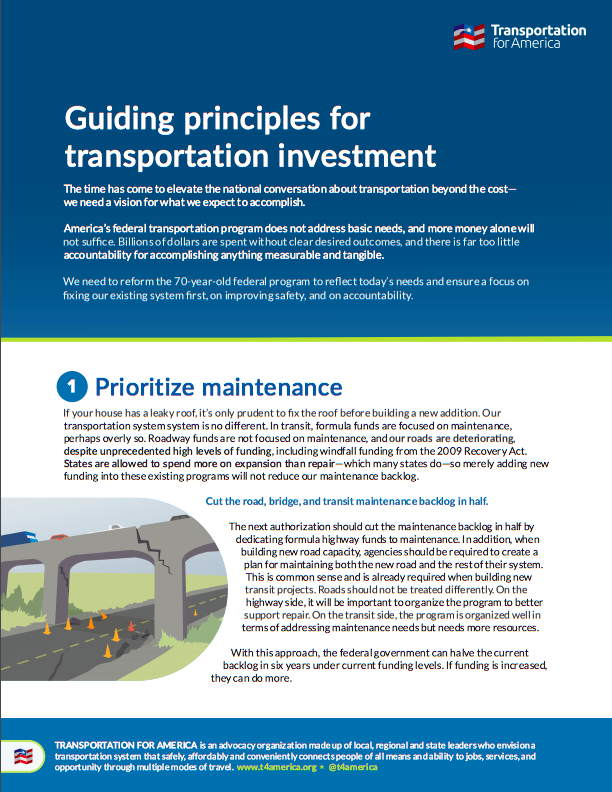
Pingback: Today’s Headlines | Streetsblog USA
Pingback: Today’s Headlines | Streetsblog California
Pingback: Tell the Feds: Don’t Turn City Streets Into Highways | Streetsblog.net
Pingback: This Week at The Markets
Pingback: Today’s Headlines | Streetsblog Ohio